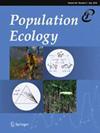Flexible parametric modeling of survival from age at death data: A mixed linear regression framework
IF 1.1
4区 环境科学与生态学
Q4 ECOLOGY
引用次数: 1
Abstract
Correspondence Etienne Rouby, Centre d'études Biologiques de Chizé, UMR 7372, Villiersen-Bois, France. Email: etienne.rouby@univ-lr.fr Abstract Many long-lived vertebrate species are under threat in the Anthropocene, but their conservation is hampered by a lack of demographic information to assess population long-term viability. When longitudinal studies (e.g., Capture-MarkRecapture design) are not feasible, the only available data may be cross-sectional, for example, stranding for marine mammals. Survival analysis deals with age at death (i.e., time to event) data and allows to estimate survivorship and hazard rates assuming that the cross-sectional sample is representative. Accommodating a bathtub-shaped hazard, as expected in wild populations, was historically difficult and required specific models. We identified a simple linear regression model with individual frailty that can fit a bathtub-shaped hazard, take into account covariates, allow goodness-of-fit assessments and give accurate estimates of survivorship in realistic settings. We first conducted a Monte Carlo study and simulated age at death data to assess the accuracy of estimates with respect to sample size. Secondly, we applied this framework on a handful of case studies from published studies on marine mammals, a group with many threatened and data-deficient species. We found that our framework is flexible and accurate to estimate survivorship with a sample size of 300. This approach is promising for obtaining important demographic information on data-poor species.从年龄到死亡数据的灵活参数建模:一个混合线性回归框架
Etienne Rouby通讯,Chizé生物研究中心,UMR 7372,法国维利森-博伊斯。电子邮件:etienne.rouby@univ-lr.fr摘要许多长寿的脊椎动物物种在人类世受到威胁,但由于缺乏评估种群长期生存能力的人口统计信息,它们的保护受到阻碍。当纵向研究(例如捕获标记捕获设计)不可行时,唯一可用的数据可能是横截面数据,例如海洋哺乳动物的搁浅。生存分析处理死亡年龄(即事件发生时间)数据,并允许在假设横断面样本具有代表性的情况下估计生存率和危险率。正如在野生种群中预期的那样,适应浴缸形状的危险在历史上是困难的,需要特定的模型。我们确定了一个具有个体脆弱性的简单线性回归模型,该模型可以拟合浴缸形状的危险,考虑协变量,允许拟合优度评估,并在现实环境中给出准确的生存率估计。我们首先进行了蒙特卡洛研究,并模拟了死亡年龄数据,以评估样本量估计的准确性。其次,我们将这一框架应用于已发表的海洋哺乳动物研究中的少数案例研究,海洋哺乳动物是一个有许多受威胁和数据不足物种的群体。我们发现,我们的框架在估计样本量为300的存活率方面是灵活和准确的。这种方法有希望获得关于数据贫乏物种的重要人口统计信息。
本文章由计算机程序翻译,如有差异,请以英文原文为准。
求助全文
约1分钟内获得全文
求助全文
来源期刊

Population Ecology
环境科学-生态学
CiteScore
3.90
自引率
11.80%
发文量
41
审稿时长
18-36 weeks
期刊介绍:
Population Ecology, formerly known as Researches on Population Ecology launched in Dec 1952, is the official journal of the Society of Population Ecology. Population Ecology publishes original research articles and reviews (including invited reviews) on various aspects of population ecology, from the individual to the community level. Among the specific fields included are population dynamics and distribution, evolutionary ecology, ecological genetics, theoretical models, conservation biology, agroecosystem studies, and bioresource management. Manuscripts should contain new results of empirical and/or theoretical investigations concerning facts, patterns, processes, mechanisms or concepts of population ecology; those purely descriptive in nature are not suitable for this journal. All manuscripts are reviewed anonymously by two or more referees, and the final editorial decision is made by the Chief Editor or an Associate Editor based on the referees'' evaluations.
 求助内容:
求助内容: 应助结果提醒方式:
应助结果提醒方式:


